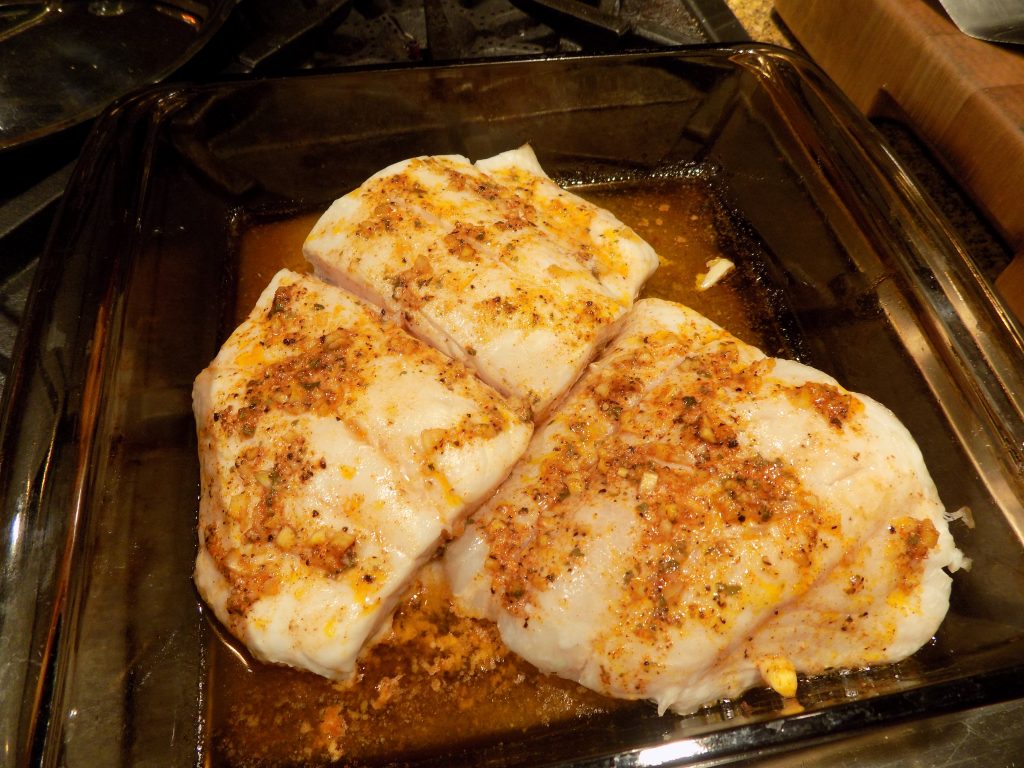
We would truly enjoy eating fresh seafood on a weekly basis. Not only for the health benefits* seafood supplies, but also because we both love the taste of almost any critter which spent its entire life in either fresh or salt water. But regrettably, dining on fresh seafood weekly just doesn’t quite happen for us. For one thing, I don’t trust the “fresh” fish selection offered by our local grocery store. (Name withheld to protect the innocent.) Second, we don’t go to Costco weekly although I love Costco’s fresh seafood selection, and finally, because fresh seafood is bloody expensive!
And granted, if push came to shove, we could afford to eat seafood on a more frequent basis. But it still doesn’t happen. So, when we do get an opportunity to feed on fish, I try my darndest to prepare it in a way that will emphasize its most admirable qualities.
So, please allow me to elucidate on the qualities of fresh halibut since that’s what this recipe is all about.
Halibut is a very lean fish, with almost sweet tasting flesh. And when cooked properly, the firm but tender texture of the fish flakes into large segments that literally melt in your mouth. (So, no pressure involved with preparing a lovely halibut fillet to avoid rendering it dry and tasteless! Right? Wrong! Unfortunately, over cooking seafood is the easiest thing in the culinary world to achieve!)
If I have learned anything in all my years of cooking seafood, it’s to err on the side of underdone. Because you can always cook it longer if necessary. But, unless you are not of this world or have some voodoo knowledge of which I am unaware, you can’t undo overdone. My solution – an instant read thermometer. And I recommend you adopt this simple solution to overcooked seafood anytime you also prepare fish. Actually, when you prepare any meat for that matter. (OK, not the meat in stew for example. You can be sure stew meat is perfectly cooked when it falls apart when you bite into it. But for rare steak, perfectly cooked pork, chicken, or slightly rare lamb, an instant read thermometer is indispensable.)
Now, about this recipe. I wanted to prepare a baked halibut dish that featured a bit of a savory topping that I hoped would complement the flavor of the fish, not disguise it. And be very easy to prepare. And with this recipe I believe I achieved my goal.
So, if you too love halibut, or any firm white fish, and want to give it a bit of a special fixing, I invite you to try this recipe. All I can say is that halibut fixed this way made for mighty fine dining for us the other evening. (If I say so myself!)
Well, that’s all I have to say on the subject of fish today. Happy cooking, happy eating, and try to stay healthy. There is a miserable cold like “something” going around our area. And I have heard it’s no darn fun. So, take especially good care of yourself as we go into the cold and flu season.
And as always, peace and love to all.
1 lb. halibut fillet
2 T. melted unsalted butter
2 tsp. fresh lemon juice
1 sm. garlic clove, finely minced
1/8 tsp. dried parsley
¼ tsp. paprika
½ tsp. kosher salt
freshly ground black pepper
Place halibut in a lightly greased baking dish.
In a small bowl, combine the melted butter, lemon juice, minced garlic, dried parsley, paprika, salt, and black pepper. Pour this mixture over halibut.
Bake in a pre-heated 400-degree oven for 12 to 15 minutes or until the fish is no longer transparent. The internal temperature should reach between 137 and 140-degrees and the fish should flake easily when tested with a fork.
Remove from oven and serve immediately.
* Seafood is known to be an excellent source of lean, high quality, easily digested protein. A 3.5-oz. serving provides almost half of an adult’s daily protein needs for only 100 to 200 calories. Seafood is also low in saturated fat and sodium and is a rich source of many essential vitamins and minerals.
